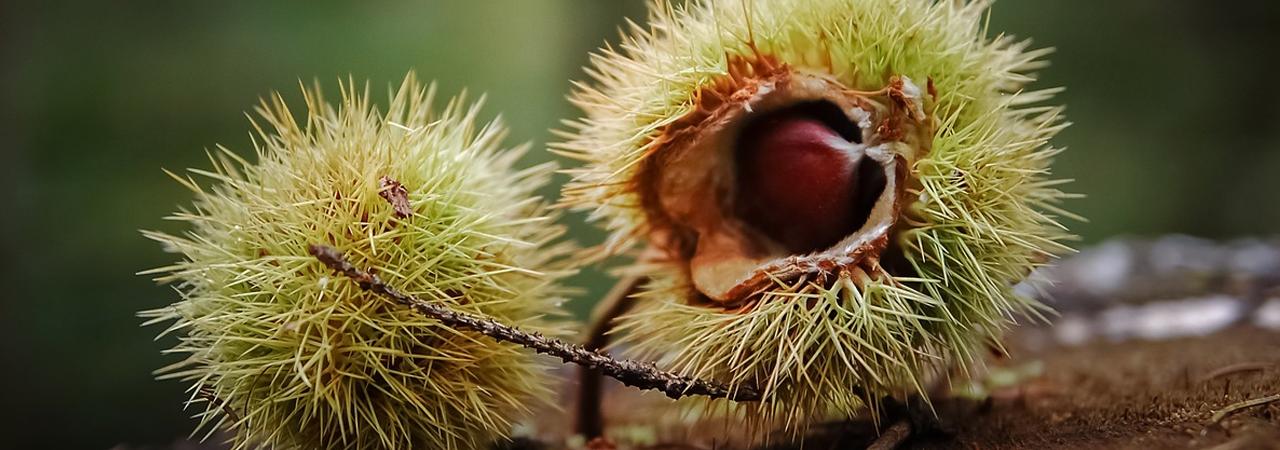American Chestnuts on Arbor Day

The healing power of nature is a much-needed remedy to the COVID 19 heartbreak. Despite the current circumstances, spring is blooming all around us. This annual rebirth reminds us of the resilience and peace of nature, and inspires us to do the same.
The month of April brings two additional reasons to celebrate nature. This year, April 22, 2020, marks the 50th anniversary of Earth Day in the United States, where folks come together to celebrate the planet as a whole. And on Arbor Day, April 24, we show special appreciation for trees.
Trees provide so many benefits, both now and during our early American conflicts. The American chestnut is one of largest, tallest and fastest-growing trees in the U.S. During the Revolutionary War and in colonial America, the American chestnut was used for building log cabins. American chestnut trees grew so large that a single tree could be used to build an entire log cabin! In the early years of our country, chestnut lumber was used for posts, poles, flooring and railroad ties. The wood was rot-resistant and straight-grained, making it suitable for furniture, fencing, and construction. And the nutritious nuts fed billions of wildlife, people and their livestock. By the time the Civil War had begun, there were nearly four billion American chestnut trees growing in the eastern U.S.
The American chestnut was almost a perfect tree, until an imported fungal blight killed more than three billion trees a century ago, reducing the population to primarily stumps and sprouts. The chestnut blight can be considered one of the greatest ecological disaster to strike the world’s forests in all of history.
Fast forward to April 2020, when our country is facing the impact of an unimaginable virus. The American chestnut tree can now be seen as a source of inspiration. Many nature-based education organizations are working to protect these majestic beauties that hold so much history as the opportunity to return this iconic tree back to the Eastern forests is within reach.
The Gettysburg Nature Alliance is a non-profit organization that works towards achieving real-world impact on the education of visitors and tourists about the history and natural habitat of the Gettysburg battlefield. Founded on a model of marrying education and enterprise for the good of the community, the Nature Alliance is committed to working with national, regional and local partners, including the Trust, The American Chestnut Foundation, the Chesapeake Bay Foundation, Strawberry Hill Foundation, Gettysburg’s Licensed Battlefield Guides, universities and school systems.
The Nature Alliance is particularly inspired by the goal of restoring the American chestnut and is taking action by partnering with The American Chestnut Foundation for a teacher training program. The American chestnut was chosen because of its rich history and catastrophic devastation. The Nature Alliance’s education team continues to work with teachers and develop curricula for science, technology, engineering and math (STEM)-related programming. The Nature Alliance’s STEM teacher-training programs demonstrate environmental challenges through programs on the American chestnut tree. Some of the programs the Alliance and the American Chestnut Foundation are working on in 2020 include:
- Build on the educational programming at the Gettysburg Heritage Center to include “habitat” programming — starting with topics about how the habitat affected Gettysburg’s heritage and helping people understand why it is so important to preserve that habitat as we move forward.
- Complete construction of the learning barn near historic Sach’s Bridge, including the planting of American, and other species, of chestnut trees, and invite students and partners to learn in a setting like no other. The bridge itself (not owned by the Nature Alliance) is listed on the National Register of Historic Places and is a popular tourist destination.
- Expand upon the solid “habitat” educational foundation laid by the Alliance’s founders and continue to explore ways to work with teachers and their students on vital STEM curricula.
- Grow community outreach, working with partners, to help visitors and residents understand the vital connection between habitat and heritage.
- Broaden educational programming that encourages people of all ages to get outside. Science has proven that being in nature — surrounded by our habitat — has positive physical and mental impact.
I hope the American chestnut, or your own favorite, resilient tree species, inspires you to seek out those special places of nature, as spring shows its colors and as we all look for hope!
Kathy Robertson
Deputy Director, Real Estate
American Battlefield Trust
P.S. Love trees? Don't miss this Friday's Head-Tilting History, all about witness trees in America's early conflicts. Not already a subscriber? Sign up now!

